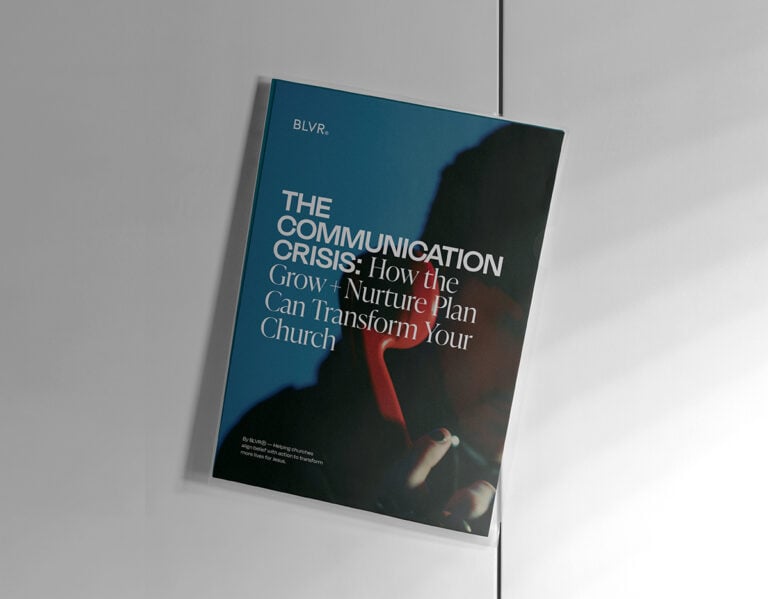
Church Branding / BY Adam Mcwethy
Why Your Church’s Communications Are Missing the Mark—and How to Fix It
Published On 02.10.2025
Article
Are Your Church Communications Effective?
If attendance is plateauing, engagement is slipping, or members of your congregation seem disconnected, the answer might be “no.” And here’s the hard truth: many churches don’t struggle because of a lack of heart or effort—they struggle because their communication strategy doesn’t reflect their belief or meet the needs of their audience.
In today’s world, where everyone is overwhelmed with noise, generic, reactive, and inward-focused communication doesn’t just miss the mark—it drives people away. Whether it’s the unchurched searching for hope or members looking for connection, fragmented and misaligned communication creates missed opportunities for growth and trust-building.
But here’s the good news: your communication strategy can be a catalyst for igniting your community. By aligning your messaging with your belief and tailoring it to your audience’s needs, your church can build trust, foster engagement, and guide more people toward Jesus.
Let’s uncover the most common communication missteps—and explore how to fix them.
The Core Problem
Churches unintentionally sabotage their growth by falling into these three communication pitfalls:
1. One-Size-Fits-All Messaging Here’s the reality: One message cannot resonate with everyone. People have diverse backgrounds, needs, and pain points. When your communication fails to reflect these differences, it feels generic and impersonal—and people disengage.
- Example: A young professional craving authentic community doesn’t want the same message as a single parent desperately looking for encouragement.
- Key Insight: Generic communication doesn’t just fail to connect—it actively alienates the people you’re trying to reach.
2. Inward-Focused Content Most church communication centers on internal updates: ministry schedules, event announcements, or logistical details. While these are important, they overlook a critical audience—the unchurched or those on the fringes of faith.
- Example: Someone outside your church, searching for hope or answers, might land on your website and only find an event calendar. What they needed was encouragement or resources to address their struggles. They leave feeling unseen.
- Key Insight: Focusing only on internal audiences means missing opportunities to reach the lost.
3. Lack of Strategy Too many churches rely on reactive communication. Posting to social media only when there’s an event, sending rushed emails, or updating the website sporadically creates fragmented and inconsistent messaging.
- Result: Without a strategic plan, communication becomes disconnected, your team burns out, and opportunities to build trust are missed.
- Key Insight: Communication without strategy creates noise, not impact.
The Solution: Align Communication with Belief-Driven Actions
Your church’s communication strategy shouldn’t just be about sharing announcements—it should be an extension of your belief in action. By aligning your communication with your church’s calling to bring hope and help, every message becomes purposeful and impactful.
Here’s how to implement a Grow + Nurture Communications Plan that reflects your belief in action:
1. Grow Your Audience Attracting new people starts with meeting them where they are—with messages that resonate with their unique needs.
- Example: A church offers a free guide on Overcoming Anxiety reaches people searching for hope while introducing them to the church’s belief in care and restoration.
- Key Insight: Growth happens when you intentionally meet people where they are and offer them something meaningful.
2. Nurture Relationships Building trust with your congregation doesn’t happen overnight. It requires consistent, intentional communication that fosters deeper connections.
- Example: A church segments it’s one-size-fits-all contact list into different audience groups, and then delivers a personalized email with helpful resources to just the men in its congregation.
- Key Insight: When your communication reflects care and understanding, relationships flourish.
3. Close the Say-Do Gap® The Say-Do Gap® is the disconnect between what your church says and how it behaves. This gap erodes trust, both internally and externally.
- Example: If your church believes in “bringing hope and healing to the broken,” every sermon, email, and post should reflect that belief. Highlight stories of people finding hope, share how your church is serving the marginalized, and invite others to be part of the mission.
- Key Insight: Aligning your words with actions builds trust and demonstrates your belief in action.
What’s at Stake if You Don’t Act?
Failing to address these communication gaps can lead to serious consequences:
1. The Unchurched Feel Overlooked A visitor seeking hope might leave your website without finding what they need, feeling unseen and unsupported.
2. Members Disengage Without intentional communication, even long-time members may feel disconnected, undervalued, and drift away.
3. Trust is Eroded A Say-Do Gap®—where your words and actions don’t align—creates confusion and mistrust, damaging your church’s credibility.
The Opportunity: Transform Your Communication Strategy
Imagine your church as a beacon of hope and connection—where every message, from a sermon to a social media post, reflects your belief and inspires action.
When your communication aligns with belief and behavior, you can:
- Build trust and foster engagement with both members and visitors.
- Reach those searching for hope and guide them toward transformation.
- Strengthen your congregation and expand your church’s ability to serve your community.
Your church’s communication strategy has the power to grow and nurture your community. Don’t let missteps hold you back.
YOUR NEW COMMS PLAN
Learn how your church can apply an approach that businesses have used to successfully acquire new customers and retain existing customers. Use the power of audience segmentation to deliver personalized messages that are relevant to each person within you external and internal church community.

About the Author

Adam Mcwethy
Partner / COO
With almost 25 years of agency experience, Adam has worked with close to 500 brands, including Globe, World Vision, Marcus & Millichap, Creative Planning, and Liberty Station to name a few. Today Adam is focused on helping churches make a larger impact by attracting new guests and fostering deeper engagement from existing members. He is able to do this by bringing the insights he’s learned over the last two-decades of working with businesses to grow and retain their customers.
© BLVR
SD / CA




